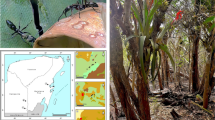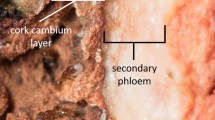Summary
Mounds of Amitermes laurensis are frequently faided by meat ants Iridomyrmex sanguineus. Of eight ant species which often cohabit with the termites, Camponotus sp. B and C were considerably dependent on the termintaria for their nest sites and effectively protected it from the attacks by meat ants. Many termite colonies cohabiting with those two ant species were vigorous, suggesting that this ant-termite relationship is mutualistic; thus, the ants were provided nest sites and probably even food and the termites were protected from destructive natural enemies.
Similar content being viewed by others
References
Bodot P (1961) La destruction des termitières de Bellicositermes natalensis par une fourmi: Dorylus (Typhlopone) dentifrons Wasmann. C R Hebd Seances Acad Sci 253:3053–3054
Brian MV (1983) Social insects: ecology and behavioural biology. Chapman and Hall, London
Deligne J, Quennedey A, Blum MS (1981) The enemies and defense mechanisms of termites. In: Hermann HR (ed) Social insects II. Academic Press, New York, pp 1–76
Ettershank G, Ettershank JA (1982) Ritualised fighting in the meat ant Iridomyrmex purpureus (Smith) (Hymenoptera: Formicidae). J Aust Entomol Soc 21:97–102
Greaves T (1971) The distribution of the three forms of the meat ant Iridomyrmex purpureus (Hymenoptera: Formicidae) in Australia. J Aust Entomol Soc 10:15–21
Greaves T (1973) Biological problems in the control of the meat ant Iridomyrmex purpureus (Smith) (Hymenoptera: Formicidae). J Aust Entomol Soc 10:15–21
Greaves T, Hughes RD (1974) The population biology of the meat ant. J Aust Entomol Soc 13:329–351
Greenslade PJM (1970) Observations on the inland variety (v. viridiaeneus Viehmeyer) of the meat ant Iridomyrmex purpureus (Frederich Smith) (Hymenoptera: Formicidae). J Aust Entomol Soc 9:227–231
Greenslade PJM (1975) Dispersion and history of a population of the meat ant Iridomyrmex purpureus (Hymenoptera: Formicidae). Aust J Zool 23:495–510
Halliday RB (1983) Social organization of meat ants Iridomyrmex purpureus analysed by electrophoresis of enzymes. Ins Soc 30:45–56
Hill GF (1922) Australian termites of the genera Drepanotermes, Hamitermes and Leucotermes. Bull Entomol Res 12:363–399
Holt JA, Greenslade PJM (1979) Ants (Hymenoptera: Formicidae) in mounds of Amitermes laurensis (Isoptera: Termitidae). J Aust Entomol Soc 18:349–361
Maschwitz U, Muehlenberg M (1975) Zur Jagdstrategie einiger orientalischer Leptogenys-Arten (Formicidae: Ponerinae). Oecologia 20:65–83
Mobbs CJ, Tedder G, Wade AM, Williams R (1978) A note on food and foraging in relation to temperature in the meat ant Irodomyrmex purpureus Form viridiaeneus. J Aust Entomol Soc 17:193–197
Redford KH (1984) The termitaria of Cornitermes cumulans (Isoptera, Termitidae) and their role in determining a potential keystone species. Biotropica 16:112–119
Taylor RW (1987) A checklist of the ants of Australia, New Caledonia and New Zealand (Hymenoptera: Formicidae). CSIRO Aust Div Entomol Rep 41:1–92
Wheeler WM (1936) Ecological relations of Ponerine and other ants to termites. Proc Am Acad Arts Sci 71:159–243
Whitford WG, Johnson PL, Ramirez J (1976) Comparative ecology of the harvester ants Pogonomyrmex barbatus (F. Smith) and Pogonomyrmex rugosus (Emery). Ins Soc 23:117–132
Wood TG, Lee KE (1971) Abundance of mounds and competition among colonies of some Australian termite species. Pedobiologia 11:341–366
Wood TG, Sands WA (1978) The role of termites in ecosystems. In: Brain MV (ed) Production ecology of ants and termites. Cambridge University Press, London New York, pp 245–292.
Author information
Authors and Affiliations
Rights and permissions
About this article
Cite this article
Higashi, S., Ito, F. Defense of termitaria by termitophilous ants. Oecologia 80, 145–147 (1989). https://doi.org/10.1007/BF00380142
Received:
Issue Date:
DOI: https://doi.org/10.1007/BF00380142




